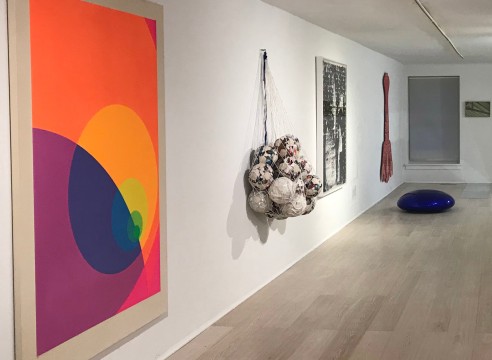
Born on January 21, 1955 in York, PA, Jeff Koons studied at the Maryland Institute College of Art and the School of the Art Institute of Chicago before moving to New York in the late 1970s, where he initially made a living as a stock broker on Wall Street. He gained popularity and fame in the 1980s when he developed iconic works like Michael Jackson and Bubbles (1988), the Made in Heaven (1990–1991) series, and Puppy (1992).
During the mid-90s, Koons expanded his Pop sensibility through the Celebration series (1994 - ) with vibrantly colored, large scale sculpture depicting Vernacular objects such as ballon dogs and flowers. The artists plays with ideas of taste, pleasure, celebrity, and commerce. “I believe in advertisement and media completely,” he says. “My art and my personal life are based in it.” Working with seductive commercial materials (such as the high chromium stainless steel of his Ballon Dog sculptures), shifts of scale, and an elaborate studio system involving many technicians, Koons turns banal objects into high art icons. In 2013, one of Koon’s Ballon Dog sculpture was sold for a recording breaking $58 million at auction, making him the most expensive living artist at the time.
Starting from 2002, the Popeye sculptures include depictions of inflatable dolphins, lobsters, and monkeys. the artist’s clarity of vision and commitment to an almost clinical level of meticulousness in his artistic process are wholly evident in Lobster. While Lobster has the appearance of a genial plastic exterior, the mirror-polished stainless steel of which it is made is also the material basis for many impeccable works of Minimalist sculpture. A complex, multilayered piece, Lobster is both a replica of a commercial product that is made for the sole purpose of bringing joy and a stunning, technically perfect sculpture with a sophisticated philosophical and art historical orientation.
One of the most recent works that joined Koon’s oeuvre is the Gazing Ball series (2012 - ), where Koons draws attention to the continuity of images as they pass through time. In each work, a blue mirrored, hand-blown glass gazing ball—a convention from eighteenth-century garden design—is affixed to a replica of a famous painting or sculpture, adding a layer of sensory experience to familiar masterpieces. Installed within these art historical milestones, the gazing ball reflects its surroundings, uniting painting, sculpture, and architecture. This series of works involves the viewers participation. As Koons mentioned in an interview with the Witney Museum of American Art “It’s about the beholder's share, that the art takes place inside the viewer. That art needs you. Art is about your transcendence“.